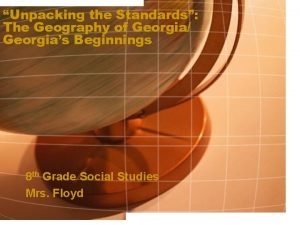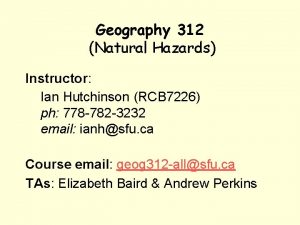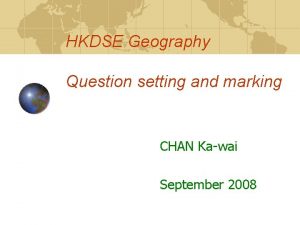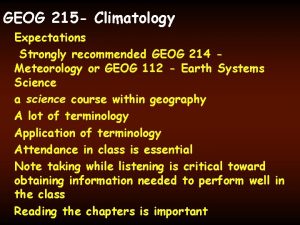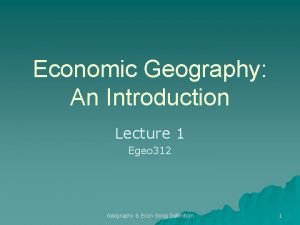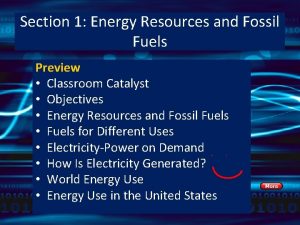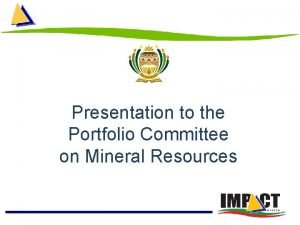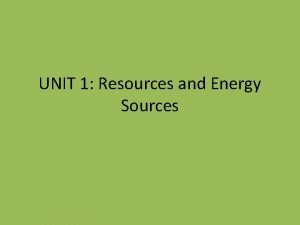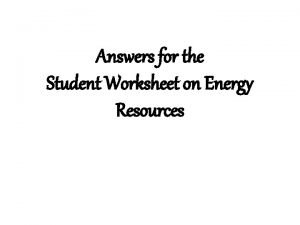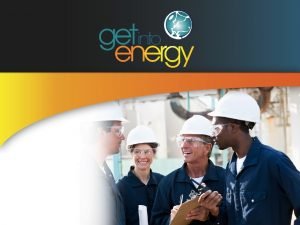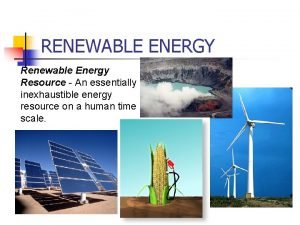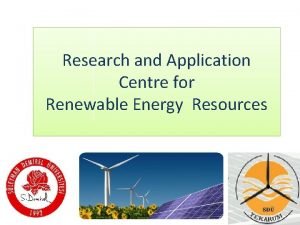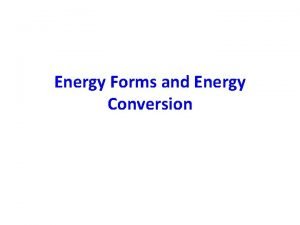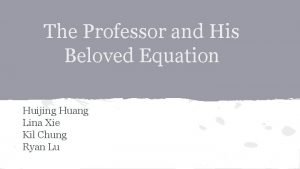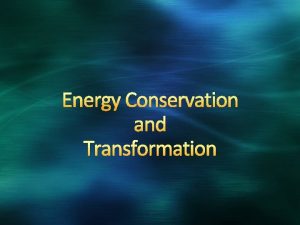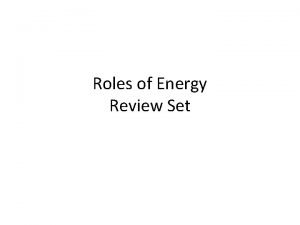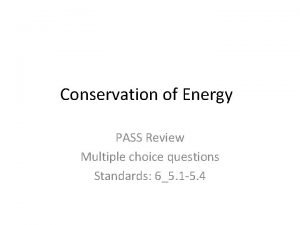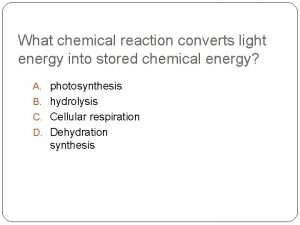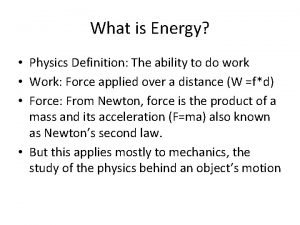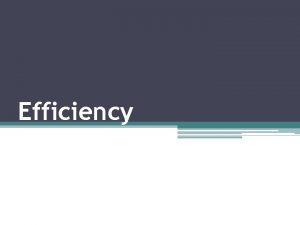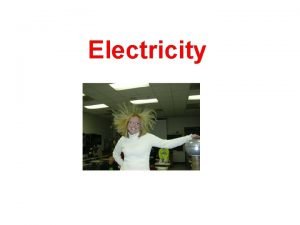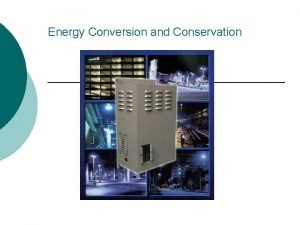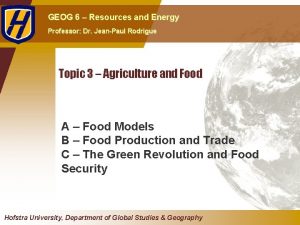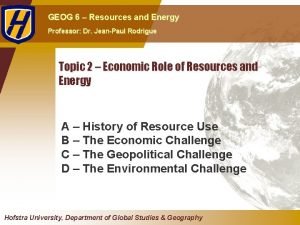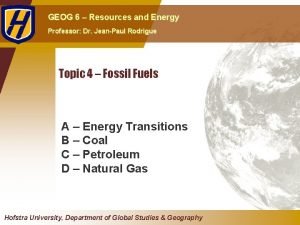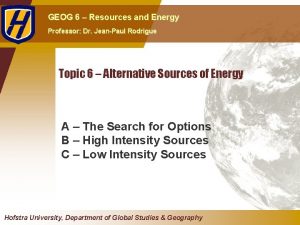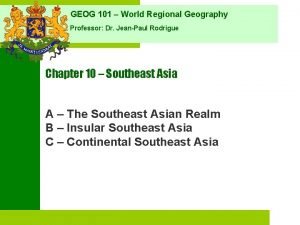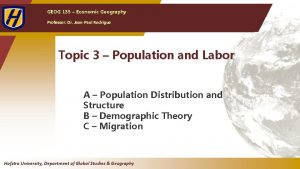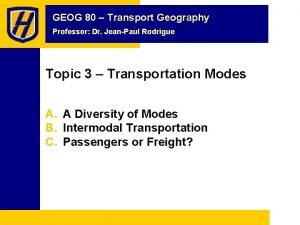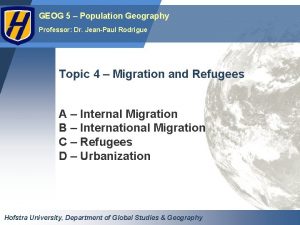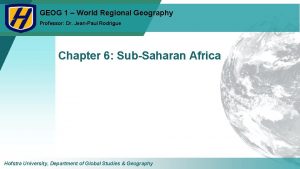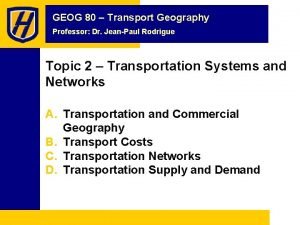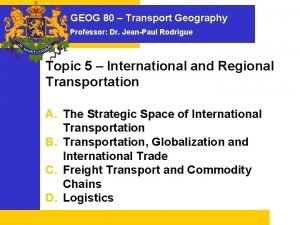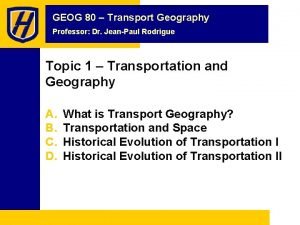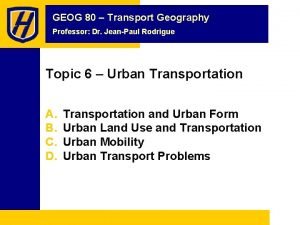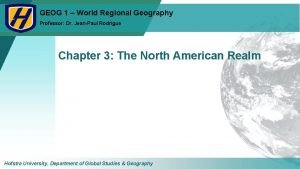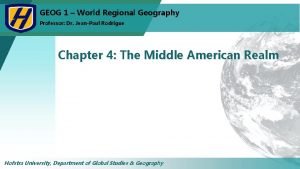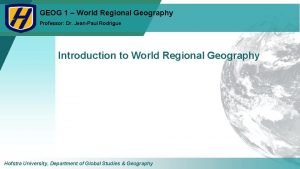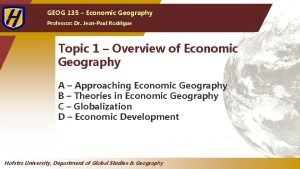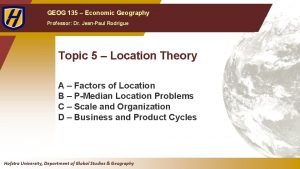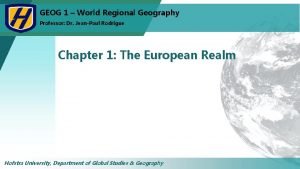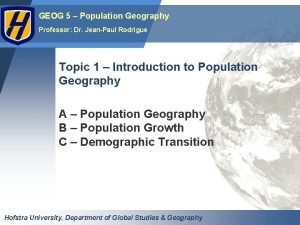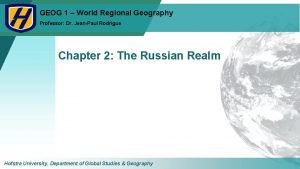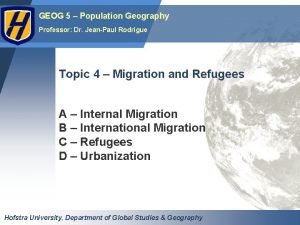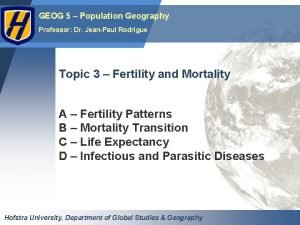GEOG 6 Resources and Energy Professor Dr JeanPaul




























































- Slides: 60

GEOG 6 – Resources and Energy Professor: Dr. Jean-Paul Rodrigue Topic 1 – What are Resources? A – Definitions B – Natural Resources C – Economic Resources D – Geographical Resources Hofstra University, Department of Global Studies & Geography

A - DEFINITIONS 1. 2. 3. 4. Types of Resources The Renewable / Non-Renewable Dichotomy Energy Resources, Technology and Society © Dr. Jean-Paul Rodrigu

1. Types of Resources Natural Geographical Minerals Biological resources Endowments Location Human Capital Economic ■ Context • A resource is something held in reserve that can be used for a purpose. • “Nature does not care”. • Three major categories of resources. ■ Natural resources • Derived from physiographical conditions. ■ Economic resources • Derived from human activities. ■ Geographical resources • Derived by spatial characteristics. © Dr. Jean-Paul Rodrigu

Natural Geographical Economic 1. Types of Resources Human resources Population and level of qualification. Commonly referred as the workforce. Capital (money) “Portable resource”. Measure the amount of resources available to an economy. Location Grants access to markets and resources. Derive wealth acting as intermediary places (Panama, Singapore, Hong Kong, the Netherlands). Endowments Scenery, mountains, beaches and coral reefs. Resources when tourism is involved. Biological resources Used to sustain life. Can be converted. Soil, water, and forestry resources. Mineral resources Fossil fuels (coal, natural gas, oil), metallic minerals (iron, aluminum, copper) and non-metallic minerals (Nitrogen, calcium, potash, sulfur, salt, sand). © Dr. Jean-Paul Rodrigu

2. The Renewable / Non-renewable Dichotomy Non-renewable Resources Renewable Resources Extraction Rate / Replenishment Rate Time Scale Geological Formed over a time scale involving geologic time. Once consumed, they disappear forever (unless recycled). Human Replenishment can occur on a human time scale (Years, decades, centuries). © Dr. Jean-Paul Rodrigu

2. The Renewable / Non-renewable Dichotomy Infiniti Millions Minerals (unless recycled) Fossil fuels (oil, coal) Millennia Centuries Years Months Soils: 200 years (permanent vegetation cover) - 1000 years (mature). Erosion is extremely important because growing populations do notareas, provide time for soils to Forests: In some theadequate rates of deforestation surpass regenerate fully. the natural ability of the forest to regenerate. Rainforest: 65 -100 years. Food: Very short growth cycle (reason why preferred as food source). Rice (3 -6 months). Chicken (12 weeks). Water: Rivers. Rain water. Aquifers. Irrigation has increased in many dry areas. Days © Dr. Jean-Paul Rodrigu

2. The Renewable / Non-renewable Dichotomy CHARACTERISTIC OIL Quantity of resource Finite Renewable or Non. Renewable Non-renewable resource Flow Transportability Only as withdrawals from fixed stocks Long-distance transport is economically viable Consumptive versus non-consumptive use Almost all use of petroleum is consumptive, converting highquality fuel into lower quality heat Substitutability The energy provided by the combustion of oil can be provided by a wide range of alternatives Prospects Limited availability; substitution inevitable by a backstop renewable source WATER Literally finite; but practically unlimited at a cost Renewable overall, but with locally non-renewable stocks Water cycle renews natural flows Long distance transport is not economically viable Some uses of water are consumptive, but many are not. Overall, water is not "consumed" from the hydrologic cycle Water has no substitute for a wide range of functions and purposes Locally limited, but globally unlimited after backstop source (e. g. desalination of oceans) is economically and Rodrigu © Dr. Jean-Paul

Non-Renewable Resources Curve Adoption Demand Usage Resource Peak Abandonment / transition Technology Time © Dr. Jean-Paul Rodrigu

3. Sources of Energy Chemical Non-Renewable • Fossil fuels (Combustion) Nuclear • Uranium (Fission of atoms) Movement • • Stored (potential) Kinetic (used) Ordered (mechanical energy) Energy Renewable Disordered (thermal energy) World’s power consumption: 12 trillion watts per year (85% from fossil fuels) Chemical • Muscular (Oxidization) Nuclear • Geothermal (Conversion) • Fusion (Fusion of hydrogen) Gravity • Tidal, hydraulic (Kinetic) Indirect Solar • Biomass (Photosynthesis) • Wind (Pressure differences) Direct Solar • Photovoltaic cell (Conversion) © Dr. Jean-Paul Rodrigu

3. Chemical Energy Content of some Fuels (in MJ/kg) Wood Ethanol Coal. . . Methanol Coal. . . Bunker C Crude Oil Jet A-1 Diesel Gasoline. . . Kerosene Natural G. . . Propane LNG Methane Hydrogen 17. 1 19. 9 23. 9 31. 1 31. 4 40. 0 41. 9 43. 3 45. 8 46. 3 47. 2 50. 3 55. 0 55. 5 142. 0 0 20 40 60 80 100 120 © Dr. Jean-Paul Rodrigu

3. Energy and Work Modification of the Environment Appropriation and Processing Transfer ■Making space suitable for human activities (20% of electricity in the US used for AC). ■Clearing land for agriculture. ■Modifying the hydrography (irrigation). ■Establishing distribution infrastructures (roads). ■Constructing and conditioning ■Extraction of resources (agricultural products and raw materials). ■Modifying resources (manufacturing). ■Disposal of wastes (Piling, decontaminating and burning). ■Movements of freight, people and information. ■Attenuate the spatial inequities in the location of resources by overcoming distance. ■Growing share of transportation in the total energy spent. © Dr. Jean-Paul Rodrigu

Main Energy Challenges Providing supply to sustain growth and requirements. A modern society depends on a stable and continuous flow of energy. Supply Demand Generate more efficient devices (e. g. Transportation; Industrial processes; Appliances). Environm ent Provide environmentally safe sources of energy. Going through the energy transition (away from fossil fuels). © Dr. Jean-Paul Rodrigu

4. Resources, Technology and Society ■ Technology • Definition: • Processes according to which tools and machines are constructed. • Insure a control of the physical environment. • Comes from the Greek word teckne (manual expertise) and logia (field of knowledge). • Therefore technology means the control, or the science, of manual expertise. • The more it is developed, the further the control and the transformation of matter is possible. • Concept of resource is tied to: • Technology (extent of available resources). • Technological change (growth in available resources and the efficiency of their use). • Culture controlling the technology (level of consumption). © Dr. Jean-Paul Rodrigu

4. Resources, Technology and Society ■ Nuance • Technology requires the systematic usage of science and especially of the scientific method. • Relationship between science, technology and production (the market). • Scientific research helps discover or improve a technology. • Changes production while creating new goods available or permitting a more efficient way to produce. Science • Comprehension of the laws of physical systems Research • Level of technical expertise over Technolo matter gy Development • Practical use of a level of Productio technical expertise n © Dr. Jean-Paul Rodrigu

Potential Depletion of Non-Renewable Resources Extract, use and discard 1 Usage Recycle, technological improvements 2 3 Recycle, reuse, reduce consumption, technological improvements Time © Dr. Jean-Paul Rodrigu

2009 2007 2005 2003 2001 1999 1997 1995 1993 1991 1989 1987 1985 1983 1981 1000 1979 1977 1975 Millions US Music Sales, 1975 -2009 1200 CD Vinyl 800 600 400 200 0 © Dr. Jean-Paul Rodrigu

4. Resources, Technology and Society ■ Consumerism • Consumption: • Always existed (mostly essential needs). • Part of social ideals; persona’s definition. • Marketing: • Department store (facility designed to incite consumption). • Advertising (create wants and needs). • Fashion (planned obsolescence). • Buying power: • • Mass consumption requires mass production. Relative price reduction of consumption goods; “mass luxury”. Higher wages. Access to credit. © Dr. Jean-Paul Rodrigu

Advertising and Psychology © Dr. Jean-Paul Rodrigu

Material Stocks in Tons per Capita 2010 2000 1990 1980 1970 1960 1950 1940 1930 1920 1910 1900 0 100 200 Timber Metals 300 400 500 Concrete Asphalt Bricks 600 700 Sand gravel 800 900 Other © Dr. Jean-Paul Rodrigu

Comparative Use of Resources, c 2000 (USA=100) Energy per capita Water per capita Energy/GNP Water/GNP EU USA GNP per Capita India Energy Use China Water Use GNP Population 0 200 400 600 800 1000 © Dr. Jean-Paul Rodrigu

Annual Resource Consumption per Person, 2001 -2002 India Paper (kg/pers. ) China Mexico United States 1624 France Japan 0 100 200 300 400 500 © Dr. Jean-Paul Rodrigu

4. Resources, Technology and Society ■ The “Resource Curse” • Paradox: • Many resource-rich countries have the poorest population. • Particularly for resources that have a high concentration level (e. g. oil, diamonds, gold). • Resources as a power support structure: • Prone to authoritarian rule, slow growth, corruption and conflict. • Resources used to finance armies, corruption and patronage. • Civil wars to gain control of resources. • The “curse”: • Instead of resources being a vector for development and capital accumulation, they become a factor of inequality. • Under investment in infrastructures, utilities, health and education. • Inverse relationship between natural resources and © Dr. Jean-Paul Rodrigu democracy.

4. Resources, Technology and Society ■ Resource loss due to destruction • Natural and man causes can destroy resources. • Natural hazards: • Earthquakes. • Weather hazards (hurricanes, tornadoes, flooding). • Forest fires. • Pollution: • Reduces the quantity and quality of natural resources such as water. • Conflicts: • Destroyed huge quantities of resources, material and human alike, throughout history. © Dr. Jean-Paul Rodrigu

B – NATURAL RESOURCES The Atmosphere The Lithosphere The Hydrosphere The Ecosphere Atmosphere Ecosphere re os he sp ro ph er yd e H Li th 1. 2. 3. 4. Biosphere © Dr. Jean-Paul Rodrigu

1. The Environmental System Atmosphere Lithosphere Hydrospher e Ecosphere Gas envelop surrounding the earth. Thin crust between the mantle and the atmosphere. Around 100 km thick. Accumulation of water in all its states (solid, liquid and gas). Set of all living organisms, including animals and vegetal. Nitrogen (78%), oxygen (21%), and traces (remaining 1%) of carbon dioxide, argon, water vapor and other components. Oxygen (47%), silicon (28%), aluminum (8%), iron (5%), calcium (4%), sodium (3%), potassium (3%) and magnesium (2%) in a crystalline state. Elements dissolved it in (sodium, magnesium, calcium, chloride and sulfate). Fast circulation. Main determinant of climate. Water covers around 71% of the earth’s surface: 97% in oceans; 2% in ice (north and south poles); 1% in rivers, lakes, ground water and atmospheric vapor. Very complex set of relationships with the atmosphere, hydrosphere and lithosphere. © Dr. Jean-Paul Rodrigu

Global Wind Patterns Principle Polar Cell Polar Front Cold (Pole) Ferrel Cell Horse Latitudes Hadley Cell Warm (Equator) Intertropical Convergence Zone TRADE WINDS Cold (Pole) WESTERLIES Global Structure © Dr. Jean-Paul Rodrigu

Seasonal Variation of Global Wind Patterns July WESTERLIES MONSOON TRADE WINDS WESTERLIES TRADE WINDS WESTERLIES January WESTERLIES MONSOON TRADE WINDS WESTERLIES TRADE WINDS WESTERLIES © Dr. Jean-Paul Rodrigu

1. Atmosphere: The World’s Climate ■ Nature • Climate is mostly composed of precipitation and temperature. • Classified according to similar attributes. • The main impact of climate on population and resources is related to its influence on food production and on comfort. • In extreme climatic conditions (hot or cold), large efforts must be made to support human life. ■ Precipitation • Involves the amount of water, in all its forms (rain, snow, hail, fog, condensation), that falls on the ground. • Influenced by many factors such as latitude, wind direction and altitude. © Dr. Jean-Paul Rodrigu

1. Atmosphere: The World’s Climate Condensation Evaporation Wind ■ Convectional rainfall • Mostly during the summer, almost everyday around the tropics. • Hot temperature causes rapid evaporation. • As the humid air climbs, it cools and causes torrential rain falls. ■ Orographic rainfall • Mostly during the monsoons. • High mountain ranges force humid air masses to climb. • It cools and rain falls. • Highest levels of precipitation are on the Indian side of the Himalayas (more than feet. Rodrigu © Dr. 30 Jean-Paul

Mean Annual Precipitation D D C B B A A B B C Equator: A band between 10 degrees north and 10 degrees south. The rainiest areas of the world (conventional A rainfall). C Low latitudes: Between 10 and 30 degrees north and 10 and 30 degrees south. Low precipitations B Middle latitudes: 20 to 50 degrees north and 20 to 50 degrees south. C High latitudes: Low precipitations (little convection). D © Dr. Jean-Paul Rodrigu

1. Atmosphere: The World’s Climate ■ Temperature • Number of days without freezing: • Important component of temperature. • Rough indication of the growing season. • For tropical regions, this figure is zero: • Vegetation grows year long, while for middle latitudes, winter can be more or less long. • Latitude, altitude and water masses and major factors influencing temperature. © Dr. Jean-Paul Rodrigu

Average Sea Surface Temperature © Dr. Jean-Paul Rodrigu

Average Insolation by Month and by Latitude 600 500 400 0 20 40 60 90 300 200 100 0 J F M A M J J A S O N D © Dr. Jean-Paul Rodrigu

2. The Lithosphere ■ The earth’s crust • Contains metallic and non-metallic minerals. • Unequal concentration and distribution because of geology. ■ Metals • Dominant mineral resources. ■ Ore • Rock in which a mineral can be mined. • Two factors for ore mining: • Market value of the mineral. • Concentration level in the ore. • There are ore rocks all over the world. • Only a small portion can be economically mined. © Dr. Jean-Paul Rodrigu

2. Composition of the Earth’s Crust 8. 2% 5. 6% 4. 1% 2. 4% 2. 3% 2. 1% 0. 5% 0. 3% 28. 2% Oxygen Silicon Aluminum Iron Calcium Sodium Magnesium Potassium Titanium 46. 3% Other © Dr. Jean-Paul Rodrigu

2. Plate Tectonics © Dr. Jean-Paul Rodrigu

2. The Lithosphere ■ Metals • Iron: • Most common and used metal. • Iron deposits can easily be mined and smelted for the ore. • Used to make steel, a highly versatile metal. • Aluminum: • Second most used metal. • Light weight and strength. • Third most common element in the crust, but difficult to extract in its most common form (silicates). • Bauxite: easier form to extract aluminum but energy intensive (electricity). ■ Nonmetallic minerals • Vary wide variety and use. • Clay. Limestone. Potash (fertilizer). Silica sand. © Dr. Jean-Paul Rodrigu

Some Minerals Used in Household Goods Good Mineral components Glass & ceramic Silica sand, limestone, talc, lithium, borates, soda ash, feldspar Fertilizers Potash, phosphate, nitrogen, sulfur Toothpaste Calcium carbonate, limestone, sodium carbonate, fluorite Lipstick Calcium carbonate, talc Caulking Limestone, gypsum Paint Titanium dioxide, kaolin clays, calcium carbonate, mica, talc, silica Concrete Limestone, gypsum, iron oxide, clay Pencil Graphite, clay Sport equipment Graphite, fiberglass Pots and pans Aluminum, iron Automobile 15 different metals and minerals Cell phone 50 different metals and minerals © Dr. Jean-Paul Rodrigu

World Mineral Reserves (years of production left), 2002 Gold 17 Zinc 22 Lead 23 36 Copper 26 Tin Nickel 46 Iron Ore 136 Bauxite 156 0 25 50 75 100 125 150 175 © Dr. Jean-Paul Rodrigu

3. Hydrosphere: World Fresh Water Supply by Source Water volume, in cubic miles Water volume, in cubic kilometers Percent of fresh water Percent of total water 321, 000 1, 338, 000 -- 96. 5 Ice caps, Glaciers, & Permanent Snow 5, 773, 000 24, 064, 000 68. 7 1. 74 Groundwater 5, 614, 000 23, 400, 000 -- 1. 7 Fresh 2, 526, 000 10, 530, 000 30. 1 0. 76 Saline 3, 088, 000 12, 870, 000 -- 0. 94 Soil Moisture 3, 959 16, 500 0. 05 0. 001 Ground Ice & Permafrost 71, 970 300, 000 0. 86 0. 022 Lakes 42, 320 176, 400 -- 0. 013 Fresh 21, 830 91, 000 0. 26 0. 007 Saline 20, 490 85, 400 -- 0. 006 Atmosphere 3, 095 12, 900 0. 04 0. 001 Swamp Water 2, 752 11, 470 0. 03 0. 0008 Rivers 509 2, 120 0. 006 0. 0002 Biological Water 269 1, 120 0. 003 0. 0001 332, 600, 000 1, 386, 000 - 100 Water source Oceans, Seas, & Bays Total © Dr. Jean-Paul Rodrigu

3. Major Oceanic Gyres © Dr. Jean-Paul Rodrigu

4. Biosphere © Dr. Jean-Paul Rodrigu

C – ECONOMIC RESOURCES 1. Human Resources 2. Capital © Dr. Jean-Paul Rodrigu

1. Human Resources ■ Economic system: • Production + distribution + consumption ■ Production side • Population provides labor: • Resource extraction. • Resource transformation. • Function of costs and qualifications. ■ Consumption side • Population consumes resources: • • Food. Energy. Goods. Services (education, healthcare). • Function of the level of income. © Dr. Jean-Paul Rodrigu

Share of the World GDP, 2008 (Current USD) United States 20% Rest of the world 47% Japan 7% China 6% Germany 5% Other G 8 15% © Dr. Jean-Paul Rodrigu

1. Human Resources ■ Evolution of the world’s population • Long historical process: • Has been very slow up to recently. • 300 million people around year 0. • Remained small until the last 250 years. • A new growth trend: • Has increased almost exponentially. • From 1. 6 billion in 1900 to 6 billion in 1999. • To what it can be linked? ■ Population “explosion” • • Defines a process of strong demographic growth. Started after the Second World War. About 80 million people added each year. The pool of human resources has thus considerably expanded. © Dr. Jean-Paul Rodrigu

World Population, 1000 BC-2050 AD (in billions) 10 9 8 7 6 5 4 3 2 1 0 -1000 -750 -500 -250 0 250 500 750 1000 1250 1500 1750 2000 © Dr. Jean-Paul Rodrigu

Population Added to the Global Population, 1950 -2008 (in millions per year) 100 2. 5 90 80 2 1. 5 50 40 1 30 20 Addition 0. 5 2007 2004 2001 1998 1995 1992 1989 1986 1983 1980 1977 1974 1971 1968 1965 1962 1959 1956 0 1953 10 1950 Millions 60 Growth Rate (%) 70 0 © Dr. Jean-Paul Rodrigu

15 Largest Countries, 2005, 2050 (in millions) Jap Vie t Phi Nam lippi nes Eg ypt Me Co xico ngo, DR Eth of iopia Bra zil Ba ngla desh Nig eria Ind ones Pa ia kista Uni n ted Stat Chi es na Indi a -18 an -200 2005 34 Growth (2005 -2050) 44 53 34 96 97 50 102 128 68 188 109 75 435 0 200 400 600 800 1, 000 1, 200 1, 400 1, 600 © Dr. Jean-Paul Rodrigu

Adult Literacy Rate (%), 1980 -2008 100 90 80 70 60 Female 50 Male 40 30 20 10 0 1980 1990 2008 © Dr. Jean-Paul Rodrigu

Composition of the World’s Population, 1960 -2008 70% 60% 50% 40% 65 and older 30% 20% 0% 1960 1962 1964 1966 1968 1970 1972 1974 1976 1978 1980 1982 1984 1986 1988 1990 1992 1994 1996 1998 2000 2002 2004 2006 2008 10% © Dr. Jean-Paul Rodrigu

2. Capital ■ Factor of production • For goods and services. • No consumed (can depreciate). • Different forms of capital (social, financial, infrastructure). • Different ways to measure. ■ Gross National Income • Total value produced within a country (i. e. its gross domestic product), together with its income received from other countries © Dr. Jean-Paul Rodrigu

$7, 000 $6, 000 $10, 000 GNI (Current USD) $9, 000 $8, 000 $5, 000 $7, 000 $6, 000 $4, 000 $5, 000 $3, 000 $4, 000 $3, 000 $2, 000 $1, 000 $0 $1, 000 1972 1974 1976 1978 1980 1982 1984 1986 1988 1990 1992 1994 1996 1998 2000 2002 2004 2006 2008 Trillions World Gross National Income (GNI) and GNI per Capita, 1972 -2008 $0 © Dr. Jean-Paul Rodrigu

2. Capital ■ Money (theory) • Unit of account (measure value). • Medium of exchange (support transactions). • Store of value (permanence in time). ■ Money (practice) • Fiat currencies: • Faith in the credit of government. • A fraudulent tool supporting state expansion. • Credit / debt driven: • Credit created “out of thin air” as debt. • Present consumption at the expense of future consumption. • Inflation: • Increase in the quantity of money/credit in relation to the pool of goods and services. • The temptation of “just a little more” credit. © Dr. Jean-Paul Rodrigu

Value of a 2009 $100 Dollar, 1800 - 2009 3, 000. 00 2, 500. 00 2, 000. 00 1, 500. 00 1, 000. 00 500. 00 180018101820183018401850186018701880189019001910192019301940195019601970198019902000 © Dr. Jean-Paul Rodrigu

D – GEOGRAPHICAL RESOURCES 1. Location 2. Endowments © Dr. Jean-Paul Rodrigu

1. Location ■ Concept • Absolute location (coordinate system). • Relative location (referring to other locations) ■ Relevance for resources • Location is a resource multiplier: • Using resources more effectively. • A city is a more effective production and consumption structure. • Some locations have higher sale potential; they differ mainly because of their accessibility. • Accessibility can be a proxy for the value of space. • A location can be a resource in itself: • Bottleneck rent effect on flows (canals, bridges, tunnels). • Capturing rent for right of passage (plus construction and maintenance of infrastructure). © Dr. Jean-Paul Rodrigu

Global Accessibility: Time to the Nearest Large City © Dr. Jean-Paul Rodrigu

Maritime Shipping Routes and Strategic Locations © Dr. Jean-Paul Rodrigu

2. Endowments ■ Amenity resources • Attributes other than factors of production (objective). • Amenity (subjective): • Climate and temperature. • Physical characteristics of the site (beach, mountain, etc. ). Cancun, Mexico • Requires infrastructure investment (Access and hospitality). • Wealth extraction based on willingness © Dr. Jean-Paul Rodrigu
 Promotion from associate professor to professor
Promotion from associate professor to professor Unit 1 geog. of ga/ga’s beginnings
Unit 1 geog. of ga/ga’s beginnings Free floating subdivisions
Free floating subdivisions Natural hazards definition ap human geography
Natural hazards definition ap human geography Hkdse geography 2020
Hkdse geography 2020 Geog 214
Geog 214 Geog
Geog Operation transformation process
Operation transformation process Fixed resources examples
Fixed resources examples Energy energy transfer and general energy analysis
Energy energy transfer and general energy analysis Energy energy transfer and general energy analysis
Energy energy transfer and general energy analysis Renewable resources vs nonrenewable resources
Renewable resources vs nonrenewable resources Fossil fuel deposit
Fossil fuel deposit Portfolio committee on mineral resources and energy
Portfolio committee on mineral resources and energy Renewable resources
Renewable resources Energy resources worksheet answers
Energy resources worksheet answers Energy resources definition
Energy resources definition Chapter 12 nonrenewable energy resources
Chapter 12 nonrenewable energy resources Concept clean energy
Concept clean energy Biomass energy advantages
Biomass energy advantages Introduction about energy resources
Introduction about energy resources Describing energy section 2 answers
Describing energy section 2 answers Primary energy and secondary energy
Primary energy and secondary energy Disadvantages of conventional energy
Disadvantages of conventional energy Helmholtz free energy and gibbs free energy
Helmholtz free energy and gibbs free energy Renewable energy and energy efficiency partnership
Renewable energy and energy efficiency partnership Elastic potential energy examples
Elastic potential energy examples Kinetic energy and potential energy formula
Kinetic energy and potential energy formula Formula of potential energy
Formula of potential energy The change in mechanical energy
The change in mechanical energy Eroei
Eroei The professor's beloved equation
The professor's beloved equation Potential energy in spring
Potential energy in spring Gibbs free energy
Gibbs free energy Gibbs free energy vs standard free energy
Gibbs free energy vs standard free energy Energy times distance
Energy times distance How are thermal energy and temperature different
How are thermal energy and temperature different A hairdryer converts ____ energy into ____ energy.
A hairdryer converts ____ energy into ____ energy. Energy equation
Energy equation How to convert mechanical energy to electrical energy
How to convert mechanical energy to electrical energy Chapter 5 thermal energy answer key
Chapter 5 thermal energy answer key Gobbs free energy
Gobbs free energy As nutritional energy passes through the food chain it is
As nutritional energy passes through the food chain it is Usable chemical energy in food begins as __________ energy.
Usable chemical energy in food begins as __________ energy. Chapter 7 energy conservation of energy
Chapter 7 energy conservation of energy Indirect solar energy
Indirect solar energy ________ converts light energy into chemical energy. *
________ converts light energy into chemical energy. * Formula of potential and kinetic energy
Formula of potential and kinetic energy Elastic potential energy examples
Elastic potential energy examples Energy in electric field
Energy in electric field Energyphysics
Energyphysics Mechanical examples
Mechanical examples Gravitational potential energy vs kinetic energy
Gravitational potential energy vs kinetic energy Ratio of useful energy to total input energy
Ratio of useful energy to total input energy Mass and thermal energy
Mass and thermal energy Kinetic potential
Kinetic potential Strong electric current
Strong electric current In an energy pyramid where is the most energy
In an energy pyramid where is the most energy Photosynthesis transforms light energy into chemical energy
Photosynthesis transforms light energy into chemical energy Energy conversion and conservation
Energy conversion and conservation Chapter 8 section 1 how organisms obtain energy answer key
Chapter 8 section 1 how organisms obtain energy answer key

